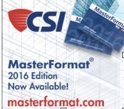Project Manuals are the other tool that is provided, along with blueprints, to enable us to assemble an accurate bid. Whether you are bidding to general contractors or directly to the owner of a project, often you will be provided with an FTP site link where you can download the “Plans and Specs”.
Once you have these “Bid Documents”, you can either print them or import them into your estimating program, such as On-Screen Takeoff, eTakeoff, or a number of free programs that you can access from certain sites such as iSqFt or BXWA .
Format and Structure
Commonly known as spec books, project manuals (along with the blueprints), are your road maps to many of the projects you will be bidding. They are intended to tell you exactly what the owner and the architect want you to do, how to do it, and when to do it.
 Virtually all spec books follow a standardized format which has been determined by the Construction Specification Institute. Although each one may vary to some degree with regards to layout and content.
Virtually all spec books follow a standardized format which has been determined by the Construction Specification Institute. Although each one may vary to some degree with regards to layout and content.
General information and requirements referred to as the Contract Documents are included, as well as instructions (specifications) for each trade. Each of these sections has been assigned a “division” number, normally ranging from Division 01 to Division 33 or higher. Sometimes, you will see the contract documents designated as Division 00.
Sections
Each division is comprised of several sections. Each section is further subdivided into parts and their subsections. Every section addresses a specific trade or function of the project. For our purposes, the areas of a project manual that will contain the majority of the information relative to painting are divisions 00, 01, and 05 through 09. This is not to say you do not need to pay attention to the other divisions as an architect may include information within any one of them that could possibly impact your bid. Items typically covered in Division 00 (Contract Requirements) are as follows:
• Who the owner is.
• When and where to submit your bid
• M/W/ESB/DVBE requirements
• Safety and environmental concerns.
• Bonds you must supply.
• Mandatory prevailing wage and per diem rates.
• Insurance requirements.
• Submittal and substitution procedures.
• Change order procedures.
• Guarantees.
• Standard contract language.
Division 01 (General Requirements) may contain some of the items listed above, as well as instructions relative to:
• Preconstruction meetings
• Publications used to establish standards
• Requirements for submittals
• Directions for use of temporary structures
• Project record documents
• Testing and laboratory services available
You are responsible to be familiar with and to comply with all of the aspects of the contract requirements and general requirements.
 Division 09 – Painting, provides much of the information that you will use to put together your bid. Within this Section is where you will find the instructions you need for painting, wall coverings, and occasionally special coatings. (Special coatings can also appear in Division 07, Thermal and Moisture Control). Usually, this section is comprised of three main parts: General requirements, Products, and Execution.
Division 09 – Painting, provides much of the information that you will use to put together your bid. Within this Section is where you will find the instructions you need for painting, wall coverings, and occasionally special coatings. (Special coatings can also appear in Division 07, Thermal and Moisture Control). Usually, this section is comprised of three main parts: General requirements, Products, and Execution.
Part 1 supplies a broad scope of general ground rules which you will be asked to comply with. These may include assurances of quality, environmental, and governmental regulations and a number of other instructions. Exactly which surfaces you are to paint will be found here as well as which ones you are not to paint.
In Part 2, you will typically find specific directions as to which manufacturers you can purchase your materials from, which materials are called for, and occasionally what colors have been selected. More often than not, you will see something similar to “Colors to be determined by the architect”. This can have a big impact on your costs if deep base colors are selected as they usually are considerably more expensive, and often don’t cover very well.
Part 3 of this Section is comprised of details relative to inspecting the surfaces to be finished and assuring that they are ready. (If you paint it, you bought it!). Be sure that the drywall contractor’s work is acceptable, scratches are sanded out of wood, all surfaces are free of dirt or grease, and so forth. In addition, you will commonly receive instructions as to acceptable temperature ranges you can work within, drying times to allow between coats, protection of surfaces not to receive finishes, proper preparation, and (pay special attention to this one) detailed instructions as to how you will be required to apply materials. This can be critical if you are limited to application by brush or roller only, or if you are directed to backroll coats of paint.
Conclusion
 Project Manuals are typically large, somewhat complex and will vary in style and content to some degree. You are, nonetheless, responsible for the entire contents. Pay particular attention to Divisions 00, 01 and 09 (099000), but keep in mind that any other division may have information you could be responsible for.
Project Manuals are typically large, somewhat complex and will vary in style and content to some degree. You are, nonetheless, responsible for the entire contents. Pay particular attention to Divisions 00, 01 and 09 (099000), but keep in mind that any other division may have information you could be responsible for.
Other than these three divisions, you are most likely to find painting requirements and specifications in Divisions 03 – 08; Concrete, Masonry, Metals, Wood, Thermal Protection and Doors.


Lynn, thanks for the article. I love that this website brings all aspects of the painting business together. Thanks again!
Thanks Eric, I hope it was a help. Stay tuned to Blogging Painters for more articles.
Lynn Jackson – Paint Precise
Quite the useful information. Subscribing so I can stay tuned to the latest articles. Definitely going to use this information when I run my business. Thank you!
Very glad it was helpful. All the best in your ventures.
Lynn Jackson